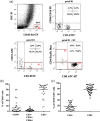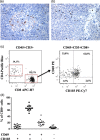Characterization of resident lymphocytes in human pancreatic islets
- PMID: 27783386
- PMCID: PMC5290249
- DOI: 10.1111/cei.12892
Characterization of resident lymphocytes in human pancreatic islets
Abstract
The current view of type 1 diabetes (T1D) is that it is an immune-mediated disease where lymphocytes infiltrate the pancreatic islets, promote killing of beta cells and cause overt diabetes. Although tissue resident immune cells have been demonstrated in several organs, the composition of lymphocytes in human healthy pancreatic islets have been scarcely studied. Here we aimed to investigate the phenotype of immune cells associated with human islets of non-diabetic organ donors. A flow cytometry analysis of isolated islets from perfused pancreases (n = 38) was employed to identify alpha, beta, T, natural killer (NK) and B cells. Moreover, the expression of insulin and glucagon transcripts was evaluated by RNA sequencing. Up to 80% of the lymphocytes were CD3+ T cells with a remarkable bias towards CD8+ cells. Central memory and effector memory phenotypes dominated within the CD8+ and CD4+ T cells and most CD8+ T cells were positive for CD69 and up to 50-70% for CD103, both markers of resident memory cells. The frequency of B and NK cells was low in most islet preparations (12 and 3% of CD45+ cells, respectively), and the frequency of alpha and beta cells varied between donors and correlated clearly with insulin and glucagon mRNA expression. In conclusion, we demonstrated the predominance of canonical tissue resident memory CD8+ T cells associated with human islets. We believe that these results are important to understand more clearly the immunobiology of human islets and the disease-related phenotypes observed in diabetes.
Keywords: T cells; diabetes; human; memory; pancreas.
© 2016 British Society for Immunology.
Figures




References
-
- Campbell‐Thompson ML, Atkinson MA, Butler AE et al The diagnosis of insulitis in human type 1 diabetes. Diabetologia 2013; 56:2541–3. - PubMed
-
- Gianani R, Campbell‐Thompson M, Sarkar SA et al Dimorphic histopathology of long‐standing childhood‐onset diabetes. Diabetologia 2010; 53:690–8. - PubMed
-
- Krogvold L, Wiberg A, Edwin B et al Insulitis and characterisation of infiltrating T cells in surgical pancreatic tail resections from patients at onset of type 1 diabetes. Diabetologia 2016; 59:492–501. - PubMed
Publication types
MeSH terms
Substances
LinkOut - more resources
Full Text Sources
Other Literature Sources
Research Materials
Miscellaneous

